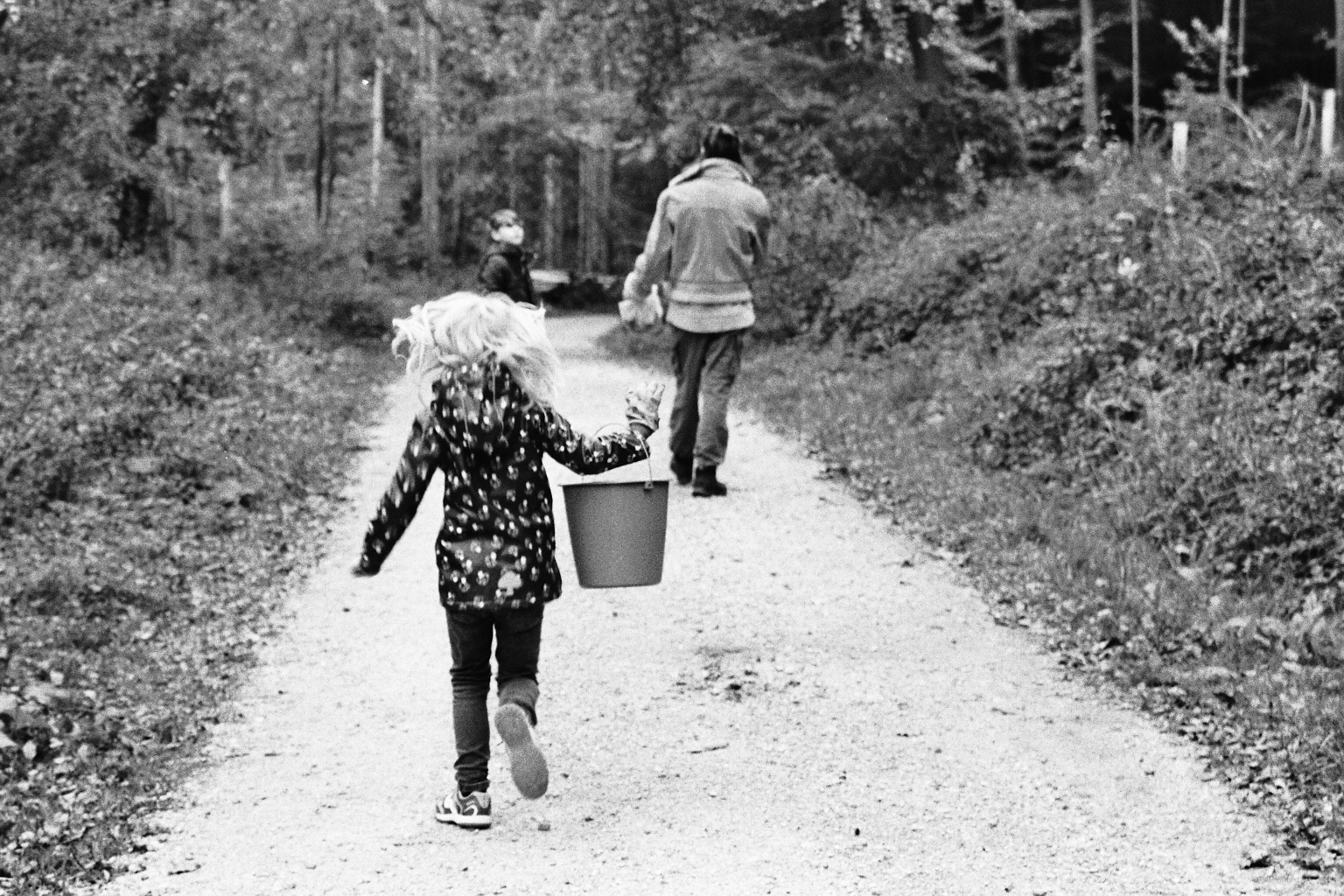
Dr. Stephen Shore once said, “If you’ve met one person with autism, you’ve met one person with autism.” The autism spectrum encompasses a wide variety of presentations and struggles, however, a quintessential part of Autism Spectrum Disorder are atypical ways of socializing and communicating. What does that imply about the way people on the spectrum make friends, and is it possible to bridge the friendship gap between different neurotypes?
Dr. Stephen Shore once said, “If you’ve met one person with autism, you’ve met one person with autism.” The autism spectrum encompasses a wide variety of presentations and struggles, however, a quintessential part of Autism Spectrum Disorder are atypical ways of socializing and communicating. What does that imply about the way people on the spectrum make friends, and is it possible to bridge the friendship gap between different neurotypes?

Photograph taken by Sarah Laszlo

Photograph taken by Sarah Laszlo
When I was 12 years old, during a conversation in English class, I said that when I grow up, I want to move to Alaska and live on my own with the reindeers. My biggest issue with this statement is that I never considered fact-checking whether reindeer actually live in Alaska, but my teacher seemed to see it differently. “Well that’s insane,” he said. “Humans are social animals, we need others to survive and thrive. You’ll last maybe two weeks in isolation.” We argued, and I truly couldn’t understand why he disagreed, or why humans allegedly needed a community when I didn’t have one and was doing perfectly fine. I would not know the answers to these questions until I got diagnosed with Autism Spectrum Disorder five years later.
It is a common misconception that autistic people inherently do not have a desire for relationships, but research states otherwise. Compared to 18% of peers without the diagnosis, 60% of young adults with autism report dissatisfaction with the number of friends they have (Finke et al., 2019). In my personal experience, this finding checks out —most of the people I’ve met who have autism also have a desire for love and friendship, but simply struggle with obtaining it. From the neurotypical’s perspective, the crosswires of communication between those on the spectrum and those not on it, are representative of effort and desire, instead of struggle. This is not a surprise. The DSM-5-TR, ergo one of the world’s most renowned diagnostic manuals, outlines the nature of ASD social aspects in terms of inferiority. The autistic way of communicating is a ‘deficit’, a ‘failure to initiate’, etc. (American Psychiatric Association, 2022). You could even say that the name itself – Autism Spectrum Disorder – sets one up for failure from the moment of diagnosis. Disorder. Characterized by disturbance, an impairment, marked by distress (World Health Organization, 2022).
The theme of deficit versus difference in the perception of the autistic person in society is an ongoing heated discussion. Truthfully, it is a debate with no definitive answer. As a study by Kapp et al. (2012) points out, this perception highly varies based on the individual symptoms, and subsequently the struggles, of every person with autism. The ‘last word’ on whether the condition should be embraced or resented is a personal choice made by the one affected, and neither position is inherently wrong or right. Moving forward, the discussion focuses on differences in place of deficits to describe autistic friendships and better understand how these differences can be accommodated, however it is important to highlight that this perspective is not representative of all experiences.
“A friend is someone who makes us feel understood. In light of what the world considers to make us weird, the mere act of proximity is crucial to combating loneliness.”
Given this heterogeneity in presentation, there is one thing that all autistic people will by definition have in common – an atypical way of socializing and communicating. We know this through the diagnostic criteria, but research further paints the picture of socializing on the spectrum. One study reports that there is a discrepancy between who autistic adolescents consider as friends within their social circle and who their parents identify as such (Kuo et al, 2011). As it turns out, autistic adolescents perceive themselves to have more friends than their parents can identify, and are not as likely as parents to report having no friends at all. And, interestingly enough, the severity of presentation of ASD symptoms did not correlate with the number of friends they possessed.
It would seem that adolescents on the spectrum perceive their closest social circle as wider than their parents do. This leads to the question – what distinguishes these perspectives? How is it possible that a parent can incorrectly assess their own child’s friendships, and more importantly, assess them as ‘lonelier’ than they are?
Another study done on adolescents with autism can help answer this question. Through interviews, the researchers tried to grasp what is defined as a friend. This is where they hit a snag. The definition of a friend was hard for them to provide, and most had difficulty with differentiating between a friend and an acquaintance, though the researchers note less emotionality in their definitions of acquaintances (Carrington et al., 2003). The aspect which they did agree upon, was that spending time together is what constitutes a friendship. Moreover, a peer engaging in their special interest seemed to be important in determining them as a friend. While they may have had difficulty with putting their experience into words, the common description of considering someone a friend based on ‘it’s just a feeling’ combined with this knowledge says something important – a friend is someone who makes us feel understood. In light of what the world considers to make us weird, the mere act of proximity is crucial to combating loneliness.
“The reason for relationships forged within the spectrum being successful is simple - unconditional acceptance.”
Further findings support this as well. In a case study of an adolescent boy, Tom, age 12, his experiences of friendship are highly based on proximity and shared interests, even if it meant putting aside his own special interest to engage in his friends’ passions. This negotiation of interests is crucial, and he put emphasis on how support and reciprocity are important to a friendship being successful, suggesting that reciprocity is present in autistic people’s relationships, albeit in a different manner. He also described the concept of a friend as someone “who responds”, whether it be a phone call or to his interest (Howard et al., 2006). Importantly, the friendships he is describing are much more harmonious than the previously discussed studies report, and potentially this may be due to the fact that his friends are also on the autistic spectrum. If there is a difference between autistic and allistic friendships, but communicating it is challenging, then it should not come as a shock that finding companionship in others who share this fundamental aspect of identity is easier than with those who do not. An aforementioned study seems to support this claim, as out of the list of closest friends, nearly half were also disabled, and 55% of which were on the spectrum (Kuo et al., 2011).
Though friendship with other peers with autism seems to come easier, bridging the gap in friendship between autistics and typically developing peers is not impossible. The reason for relationships forged within the spectrum being successful is simple – unconditional acceptance. A study done on young adults on the spectrum reports that the most fruitful friendships included an acceptance and appreciation of social differences and cultivating shared interests (Sosnowy et al., 2018). The key to their success is having autistic traits treated as any other set of needs, letting their individual experience precede the social stigma behind the diagnosis.
The topic of friendships on the autism spectrum is one that could easily be the subject matter of a PhD thesis, but there’s only so much that can be said in an article. When it comes down to it, there seems to be more common ground than assumed – no matter the neurology, we all just want someone who lets us be ourselves in their presence, without judgment. Someone to listen, not just hear. To notice, not just see. And with this in mind, the ridge between two worlds suddenly seems much more crossable. <<
References
-
American Psychiatric Association. (2022). Diagnostic and statistical manual of mental disorders (5th ed., text rev.)
-
Carrington, S., Templeton, E., & Papinczak, T. (2003). Adolescents with Asperger Syndrome and perceptions of friendship. Focus on Autism and Other Developmental Disabilities, 18(4), 211–218. https://doi.org/10.1177/10883576030180040201
-
Finke, E. H., McCarthy, J. H., & Sarver, N. A. (2019). Self-perception of friendship style: Young adults with and without autism spectrum disorder. Autism & Developmental Language Impairments, 4. https://doi.org/10.1177/2396941519855390
-
Howard, B., Cohn, E., & Orsmond, G. I. (2006). Understanding and negotiating friendships. Autism, 10(6), 619–627. https://doi.org/10.1177/1362361306068508
-
Kapp, S. K., Gillespie-Lynch, K., Sherman, L. E., & Hutman, T. (2012). Deficit, difference, or both? Autism and neurodiversity. Developmental Psychology. https://doi.org/10.1037/a0028353
-
Kuo, M. H., Orsmond, G. I., Cohn, E., & Coster, W. J. (2013). Friendship characteristics and activity patterns of adolescents with an autism spectrum disorder. Autism, 17(4), 481–500. https://doi.org/10.1177/1362361311416380
-
Sosnowy, C., Silverman, C., Shattuck, P., & Garfield, T. (2019). Setbacks and successes: How young adults on the autism spectrum seek friendship. Autism in Adulthood, 1(1), 44–51. https://doi.org/10.1089/aut.2018.0009
-
World Health Organization: WHO. (2022). Mental disorders. www.who.int. https://www.who.int/news-room/fact-sheets/detail/mental-disorders#:~:text=A%20mental%20disorder%20is%20characterized,in%20important%20areas%20of%20functioning.
When I was 12 years old, during a conversation in English class, I said that when I grow up, I want to move to Alaska and live on my own with the reindeers. My biggest issue with this statement is that I never considered fact-checking whether reindeer actually live in Alaska, but my teacher seemed to see it differently. “Well that’s insane,” he said. “Humans are social animals, we need others to survive and thrive. You’ll last maybe two weeks in isolation.” We argued, and I truly couldn’t understand why he disagreed, or why humans allegedly needed a community when I didn’t have one and was doing perfectly fine. I would not know the answers to these questions until I got diagnosed with Autism Spectrum Disorder five years later.
It is a common misconception that autistic people inherently do not have a desire for relationships, but research states otherwise. Compared to 18% of peers without the diagnosis, 60% of young adults with autism report dissatisfaction with the number of friends they have (Finke et al., 2019). In my personal experience, this finding checks out —most of the people I’ve met who have autism also have a desire for love and friendship, but simply struggle with obtaining it. From the neurotypical’s perspective, the crosswires of communication between those on the spectrum and those not on it, are representative of effort and desire, instead of struggle. This is not a surprise. The DSM-5-TR, ergo one of the world’s most renowned diagnostic manuals, outlines the nature of ASD social aspects in terms of inferiority. The autistic way of communicating is a ‘deficit’, a ‘failure to initiate’, etc. (American Psychiatric Association, 2022). You could even say that the name itself – Autism Spectrum Disorder – sets one up for failure from the moment of diagnosis. Disorder. Characterized by disturbance, an impairment, marked by distress (World Health Organization, 2022).
The theme of deficit versus difference in the perception of the autistic person in society is an ongoing heated discussion. Truthfully, it is a debate with no definitive answer. As a study by Kapp et al. (2012) points out, this perception highly varies based on the individual symptoms, and subsequently the struggles, of every person with autism. The ‘last word’ on whether the condition should be embraced or resented is a personal choice made by the one affected, and neither position is inherently wrong or right. Moving forward, the discussion focuses on differences in place of deficits to describe autistic friendships and better understand how these differences can be accommodated, however it is important to highlight that this perspective is not representative of all experiences.
“A friend is someone who makes us feel understood. In light of what the world considers to make us weird, the mere act of proximity is crucial to combating loneliness.”
Given this heterogeneity in presentation, there is one thing that all autistic people will by definition have in common – an atypical way of socializing and communicating. We know this through the diagnostic criteria, but research further paints the picture of socializing on the spectrum. One study reports that there is a discrepancy between who autistic adolescents consider as friends within their social circle and who their parents identify as such (Kuo et al, 2011). As it turns out, autistic adolescents perceive themselves to have more friends than their parents can identify, and are not as likely as parents to report having no friends at all. And, interestingly enough, the severity of presentation of ASD symptoms did not correlate with the number of friends they possessed.
It would seem that adolescents on the spectrum perceive their closest social circle as wider than their parents do. This leads to the question – what distinguishes these perspectives? How is it possible that a parent can incorrectly assess their own child’s friendships, and more importantly, assess them as ‘lonelier’ than they are?
Another study done on adolescents with autism can help answer this question. Through interviews, the researchers tried to grasp what is defined as a friend. This is where they hit a snag. The definition of a friend was hard for them to provide, and most had difficulty with differentiating between a friend and an acquaintance, though the researchers note less emotionality in their definitions of acquaintances (Carrington et al., 2003). The aspect which they did agree upon, was that spending time together is what constitutes a friendship. Moreover, a peer engaging in their special interest seemed to be important in determining them as a friend. While they may have had difficulty with putting their experience into words, the common description of considering someone a friend based on ‘it’s just a feeling’ combined with this knowledge says something important – a friend is someone who makes us feel understood. In light of what the world considers to make us weird, the mere act of proximity is crucial to combating loneliness.
“The reason for relationships forged within the spectrum being successful is simple - unconditional acceptance.”
Further findings support this as well. In a case study of an adolescent boy, Tom, age 12, his experiences of friendship are highly based on proximity and shared interests, even if it meant putting aside his own special interest to engage in his friends’ passions. This negotiation of interests is crucial, and he put emphasis on how support and reciprocity are important to a friendship being successful, suggesting that reciprocity is present in autistic people’s relationships, albeit in a different manner. He also described the concept of a friend as someone “who responds”, whether it be a phone call or to his interest (Howard et al., 2006). Importantly, the friendships he is describing are much more harmonious than the previously discussed studies report, and potentially this may be due to the fact that his friends are also on the autistic spectrum. If there is a difference between autistic and allistic friendships, but communicating it is challenging, then it should not come as a shock that finding companionship in others who share this fundamental aspect of identity is easier than with those who do not. An aforementioned study seems to support this claim, as out of the list of closest friends, nearly half were also disabled, and 55% of which were on the spectrum (Kuo et al., 2011).
Though friendship with other peers with autism seems to come easier, bridging the gap in friendship between autistics and typically developing peers is not impossible. The reason for relationships forged within the spectrum being successful is simple – unconditional acceptance. A study done on young adults on the spectrum reports that the most fruitful friendships included an acceptance and appreciation of social differences and cultivating shared interests (Sosnowy et al., 2018). The key to their success is having autistic traits treated as any other set of needs, letting their individual experience precede the social stigma behind the diagnosis.
The topic of friendships on the autism spectrum is one that could easily be the subject matter of a PhD thesis, but there’s only so much that can be said in an article. When it comes down to it, there seems to be more common ground than assumed – no matter the neurology, we all just want someone who lets us be ourselves in their presence, without judgment. Someone to listen, not just hear. To notice, not just see. And with this in mind, the ridge between two worlds suddenly seems much more crossable. <<
References
-
American Psychiatric Association. (2022). Diagnostic and statistical manual of mental disorders (5th ed., text rev.)
-
Carrington, S., Templeton, E., & Papinczak, T. (2003). Adolescents with Asperger Syndrome and perceptions of friendship. Focus on Autism and Other Developmental Disabilities, 18(4), 211–218. https://doi.org/10.1177/10883576030180040201
-
Finke, E. H., McCarthy, J. H., & Sarver, N. A. (2019). Self-perception of friendship style: Young adults with and without autism spectrum disorder. Autism & Developmental Language Impairments, 4. https://doi.org/10.1177/2396941519855390
-
Howard, B., Cohn, E., & Orsmond, G. I. (2006). Understanding and negotiating friendships. Autism, 10(6), 619–627. https://doi.org/10.1177/1362361306068508
-
Kapp, S. K., Gillespie-Lynch, K., Sherman, L. E., & Hutman, T. (2012). Deficit, difference, or both? Autism and neurodiversity. Developmental Psychology. https://doi.org/10.1037/a0028353
-
Kuo, M. H., Orsmond, G. I., Cohn, E., & Coster, W. J. (2013). Friendship characteristics and activity patterns of adolescents with an autism spectrum disorder. Autism, 17(4), 481–500. https://doi.org/10.1177/1362361311416380
-
Sosnowy, C., Silverman, C., Shattuck, P., & Garfield, T. (2019). Setbacks and successes: How young adults on the autism spectrum seek friendship. Autism in Adulthood, 1(1), 44–51. https://doi.org/10.1089/aut.2018.0009
-
World Health Organization: WHO. (2022). Mental disorders. www.who.int. https://www.who.int/news-room/fact-sheets/detail/mental-disorders#:~:text=A%20mental%20disorder%20is%20characterized,in%20important%20areas%20of%20functioning.



